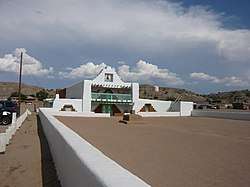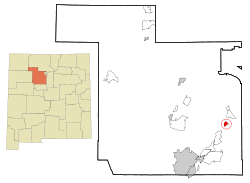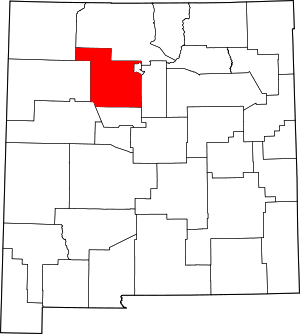Kewa Pueblo, New Mexico
Kewa Pueblo (Eastern Keres [kʰewɑ], Navajo: Tó Hájiiloh), formerly known as Santo Domingo Pueblo, is a census-designated place (CDP) in Sandoval County, New Mexico, United States and a federally recognized tribe of Native American Pueblo people.
Kewa Pueblo, New Mexico | |
|---|---|
 Pueblo of Santo Domingo Mission Church | |
 Location of Kewa Pueblo, New Mexico | |
 Kewa Pueblo, New Mexico Location in the United States | |
| Coordinates: 35°30′52″N 106°21′48″W | |
| Country | United States |
| State | New Mexico |
| County | Sandoval |
| Area | |
| • Total | 2.0 sq mi (5.2 km2) |
| • Land | 2.0 sq mi (5.2 km2) |
| • Water | 0.0 sq mi (0.0 km2) |
| Elevation | 5,187 ft (1,581 m) |
| Population (2010 census[1] =) | |
| • Total | 2,456 |
| • Density | 1,228/sq mi (472.3/km2) |
| Time zone | UTC-7 (Mountain (MST)) |
| • Summer (DST) | UTC-6 (MDT) |
| Area code(s) | 505 |
| FIPS code | 35-70810 |
| GNIS feature ID | 0928818 |
The population of the pueblo is composed of Native Americans who speak Keres, an eastern dialect of the Keresan languages. Like several other pueblo peoples, they have a matrilineal kinship system,[2] in which children are considered born into the mother's family and clan, and inheritance and property pass through the maternal line. The Pueblo celebrates an annual feast day on August 4 to honor their patron saint, Saint Dominic. More than 2,000 pueblo people participate in the traditional corn dances held at this time.
Name
In the 17th century, the Spanish conquistadores named the pueblo as Santo Domingo. Its earliest recorded name was Gipuy. According to Pueblo Council members, the local name in their Keres language has always been Kewa. In 2009, the pueblo officially changed its name to Kewa Pueblo, altering its seal, signs and letterhead.[3] According to the Pueblo of Acoma's Keres Online Dictionary, the Western Keresan-name for the Pueblo was Díiwʾi and for its people therefore Dîiwʾamʾé.[4]
Geography
Kewa Pueblo is located at 35°30′52″N 106°21′48″W (35.514483, -106.363429).[5] The pueblo is located approximately 25 miles (40 km) southwest of Santa Fe. Interstate 25 runs 4 miles (6 km) to the east of the community. The CDP is part of the Albuquerque Metropolitan Statistical Area.
According to the United States Census Bureau, the CDP has a total area of 2.0 square miles (5.2 km2), all of it land.
Demographics
The 2010 census found that 2,456 people lived in the CDP,[1] while 3,519 people in the U.S. reported being exclusively Santo Domingo Puebloan[6] and 4,430 people reported being Santo Domingo Puebloan exclusively or in combination with another group.[7]
The State of New Mexico says the population is 3,100.[8]
History
The pueblo plays a supporting role in Spanish colonial history. Gaspar Castaño de Sosa, a fugitive from the Crown, was arrested at the pueblo in March 1591. Castaño, a notorious slaver, had fled capture. He pursued an illegal claims expedition up the Pecos River, which had not yet been seen by Europeans. He made it as far as Pecos pueblo, and raided it for slaves. He turned west and traveled toward modern-day Santa Fe, which had been established by the Spanish. He followed the Rio Grande river valley south. On orders of the Viceroy at Mexico City, Captain Juan Morlette found Castaño at Kewa pueblo and arrested him. He returned him to authorities to face trial for his crimes, including his attack on Pecos pueblo.
Castaño abandoned two interpreters at Kewa Pueblo; he had kidnapped them earlier and brought them with him. Governor Juan de Oñate's expedition recorded encountering Tomas and Cristobal at Kewa Pueblo, as it traveled north.
20th century to present
.tiff.jpg)
Potters of Kewa and Cochiti pueblos have made traditional pots for centuries, developing styles for different purposes and expressing deep beliefs in their designs. Since the early decades of the 20th century, these pots have been appreciated by a wider audience outside the pueblos. Continuing to use traditional techniques, in the late 20th and early 21st centuries, potters have also expanded their designs and repertoire in pottery, which has an international market.
Arts
Kewa artists are known for their stonework jewelry,[9] including flat disks or beads called heishi, meaning "shell bead" in Eastern Keresan, which are often made into necklaces.[10][11]
Pottery is an important art form and utilitarian craft from Kewa Pueblo.[12][13] Large ollas and dough bowls are common forms for Kewa potters. Many Kewa potters are women, although men can also create ceramics.[9][12] The Aguilar Family, consisting of three sisters, created Kewa pottery from 1910 until approx. 1915 and became very well known for their artwork.[14][15]
Notes
- U.S. Census Bureau (2010). "NM - Santo Domingo Pueblo CDP". United States Census 2010. Retrieved March 9, 2018.
- Ross Frank (29 January 2007). From Settler to Citizen: New Mexican Economic Development and the Creation of Vecino Society, 1750-1820. University of California Press. p. 6. ISBN 978-0-520-25159-5.
- Constable, Anne (9 March 2010), "Pueblo returns to traditional name: Santo Domingo quietly becomes 'Kewa'; tribe alters seal, signs and letterhead", The New Mexican (Santa Fe, New Mexico), archived here at WebCite
- Keres Online Dictionary
- "US Gazetteer files: 2010, 2000, and 1990". United States Census Bureau. 2011-02-12. Retrieved 2011-04-23.
- Census 2010 American Indian and Alaska Native Summary File (AIANSF) - Sample Data, Pueblo of Santo Domingo alone (H59)
- Census 2010 American Indian and Alaska Native Summary File (AIANSF) - Sample Data, Pueblo of Santo Domingo alone or in any combination (H59) & (100-299) or (300, A01-Z99) or (400-999)
- "Santo Domingo Pueblo". New Mexico, Land of Enchantment. New Mexico Tourism Department. Retrieved March 8, 2018.
- Schaaf, Gregory (2002). Southern Pueblo pottery : 2000 artist biographies, c. 1800-present : with value/price guide featuring over 20 years of auction records. Schaaf, Angie Yan. (1st ed.). Santa Fe, N.M.: CIAC Press. p. 5. ISBN 0966694856. OCLC 48624322.
- Carolyn McCarthy; Hugh McNaughtan; Christopher Pitts; Benedict Walker (2018). Lonely Planet Southwest USA. Lonely Planet. p. 486. ISBN 978-1-78701-943-0.
- Rose, Elizabeth R. "What You Need to Know About Native American Heishi Jewelry". TripSavvy.
- 1959-, Berger, Guy (2004). Pueblo and Navajo contemporary pottery and directory of artists. Schiffer, Nancy. (2nd., rev. and enl ed.). Atglen, PA: Schiffer. pp. 78–80. ISBN 0764318969. OCLC 57013886.CS1 maint: numeric names: authors list (link)
- 1950-, Trimble, Stephen (1987). Talking with the clay : the art of Pueblo pottery (1st ed.). Santa Fe, N.M.: School of American Research Press. ISBN 0933452152. OCLC 15082081.CS1 maint: numeric names: authors list (link)
- "Kewa (Santo Domingo) pottery jar". Marcy Burns American Indian Arts. Retrieved 2019-02-01.
- "Kewa - Santo Domingo Pueblo Pottery". Adobe Gallery. Retrieved 2019-02-01.
Further reading
- Chapman, Kenneth Milton (1977). The Pottery of Santo Domingo Pueblo: A Detailed Study of Its Decoration. School of American Research, University of New Mexico Press, Albuquerque, New Mexico, ISBN 0-8263-0460-5; original published in 1936 as volume 1 of the Memoirs of the Laboratory of Anthropology OCLC 3377512
- Richard H. Frost, The Railroad and the Pueblo Indians: The Impact of the Atchison, Topeka and Santa fe on the Pueblos of the Rio Grande, 1880-1930. 2016, Salt Lake City: University of Utah Press. ISBN 978-1-607-81440-5
- Verzuh, Valerie K. (2008). A River Apart: The Pottery of Cochiti and Santo Domingo Pueblos. Museum of New Mexico Press, Santa Fe, New Mexico, ISBN 978-0-89013-522-8
External links
- Keres Pueblo Indians – Encyclopedia of World Cultures
